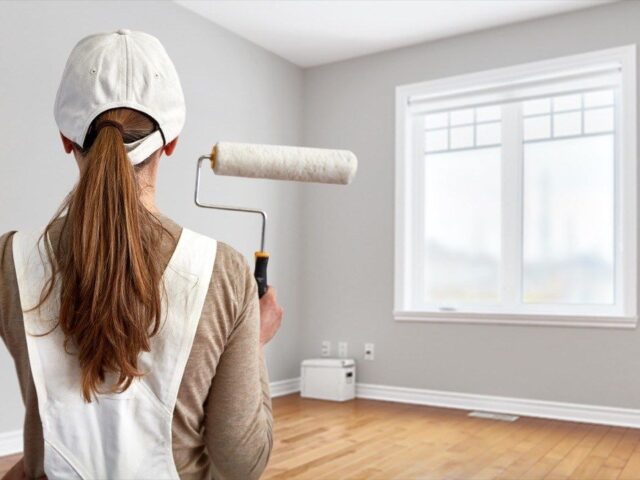Enhance Your Interior Decoration With Comprehensive Shade Appointment
The integration of shade examination right into interior design offers an unique chance to refine and boost the visual and emotional resonance of a space. By involving with an experienced color professional, you can browse the complexities of shade choice, guaranteeing that your choices not just complement building functions but additionally resonate with personal design and psychological impact.
Advantages of Shade Assessment

Additionally, shade appointment aids in making best use of natural light and optimizing spatial understanding. Lighter colors can make an area show up even more expansive, while darker tones create an intimate setting. Cleveland Metro Painting Specialists. This tactical application of color can substantially affect the total setting of any kind of indoor room
In addition, professional consultants possess a comprehensive understanding of classic standards and existing fads, making certain that the picked shades will certainly stay attractive gradually. This insight can save clients from costly redesigns in the future. Color consultation encourages customers by supplying them with a clear vision and direction, fostering self-confidence in their layout selections and eventually leading to a more rewarding and successful indoor design result.
Comprehending Color Psychology
The value of shade psychology in interior decoration can not be overemphasized, as it looks into the psychological and psychological effects that numerous hues can evoke in individuals. Shades can affect state of mind, behavior, and also productivity, making them a crucial consideration in any kind of style task.
For instance, cozy colors such as red, orange, and yellow are often connected with power and warmth. They can boost feelings of exhilaration and comfort, making them appropriate for social spaces like living kitchen areas or areas. Conversely, trendy colors like blue, eco-friendly, and purple tend to evoke peace and tranquility, making them ideal for bed rooms or reflection areas.
Furthermore, making use of neutral tones can create a balanced setting by allowing the bolder colors to attract attention without overwhelming the senses. Recognizing these psychological effects allows developers to develop spaces that not only look visually pleasing but also promote psychological health.
Incorporating shade psychology right into interior style includes a thoughtful option of tones tailored to the intended function of each area, eventually boosting the overall experience for its occupants. This recognition is crucial for accomplishing a unified and functional indoor setting.
The Shade Wheel Described
It comprises key shades-- red, blue, and yellow-- that can not be produced by mixing various other colors. Tertiary colors result from blending a main and a secondary shade, leading to colors such as turquoise and red-orange.
The color wheel aids designers comprehend the connections in between colors, including complementary, analogous, and triadic plans. Complementary shades, located opposite each various other on the wheel, create lively contrasts that can stimulate a room.
Using the shade wheel in interior layout not only boosts aesthetic allure but additionally evokes specific feelings and atmospheres, making it an important referral for color appointment. Understanding these connections ultimately encourages designers to create areas that are both functional and aesthetically fascinating.
Selecting the Right Combination
An appropriate color scheme can combine an area, enhance its features, and stimulate preferred emotions. Different spaces serve diverse features and need combinations that show their intended usage; for circumstances, relaxing colors such as soft blues or environment-friendlies work well in bedrooms, advertising relaxation.
Following, think about the all-natural light available. Light can substantially modify just how shades appear, so it is vital to assess the space at various times of the day. Furthermore, think about existing architectural aspects and furnishings. A harmonious scheme must match these attributes, developing a natural look throughout the space.
When selecting colors, utilize the 60-30-10 regulation, which recommends that 60% of the area should be a leading color, 30% an additional shade, and 10% an accent color. This proportion makes certain balance and aesthetic interest (Cleveland Metro Painting Specialists). Sample colors on the walls prior to committing, as this permits you to see just how the colors interact with one another and the total atmosphere they produce in your interior layout job.
Collaborating With a Shade Professional

When collaborating with a color consultant, the procedure commonly starts with a first appointment. Throughout this conference, you'll review your vision, preferences, and the existing elements in your area. The expert will evaluate your needs and may advise specific shade palettes that align with your goals.
After developing an instructions, the expert will provide examples and aesthetic help to aid you picture the recommended color schemes. This action is critical, as shades can appear in a different way under varying lighting problems.
Furthermore, a color professional can assist you in choosing complementary home furnishings, art work, and accessories to integrate with your selected palette. By teaming up carefully, you can achieve a polished aesthetic that raises your interiors and produces an inviting ambience. Eventually, the proficiency of a shade professional can dramatically enhance the total effect of your design job.
Conclusion
In summary, extensive shade consultation serves as a crucial device for boosting interior design. By try here leveraging professional understanding of shade psychology and spatial characteristics, a customized color palette can be established to evoke certain feelings and develop an unified environment.
By engaging with a seasoned color specialist, you can navigate the complexities of color choice, making sure that your selections not just enhance building attributes yet also reverberate with individual design and emotional influence. It consists of key shades-- red, blue, and yellow-- that can not be developed by blending various other shades.The shade wheel assists developers comprehend the partnerships in between shades, consisting of complementary, similar, and triadic schemes.When selecting colors, utilize the 60-30-10 rule, which suggests that 60% of the room need to be a leading shade, 30% a second shade, and 10% an accent shade. By leveraging professional understanding of color psychology and spatial dynamics, a customized shade scheme can anonymous be established to evoke particular emotions and create an unified setting.